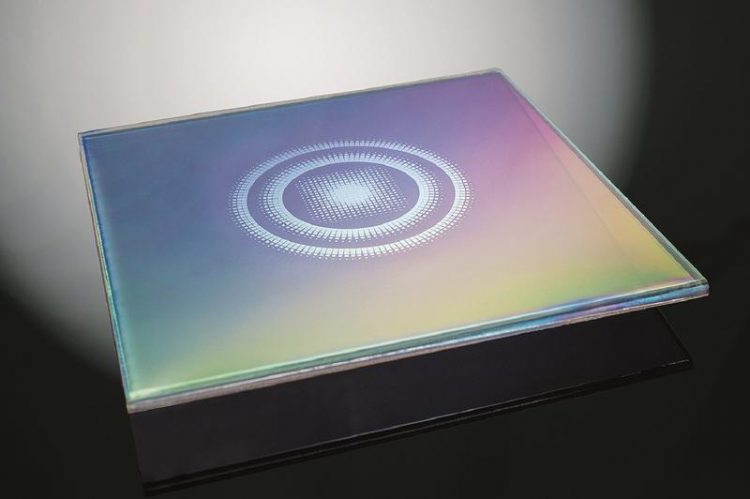RadarGlass: Functional thin-film structures for integrated radar sensors

With an electrically conductive thin film for headlamp covers, radar beams can be specifically shaped and directed. © Fraunhofer ILT, Aachen, Germany
Completely autonomous vehicles pose an enormous challenge for sensor technology because, in principle, the supporting system must hear, see and feel better than humans. While the corresponding sensors are available – in particular since a large number of assistance systems have already been installed – developers are always faced with the question of where they can be placed best.
In the case of radar sensors, it makes sense to install them in the front headlamps. “It's the perfect position because they completely cover the near and far range and allow you to look to the side,“ explains Dipl.-Phys. Patrick Gretzki, scientist in the Micro and Nano Structuring group at Fraunhofer ILT.
“Since the light source generates so much heat, the sensors are also always free of snow and water even under harsh weather conditions.”
Coating directs the radar beam
The three institutes cover all the necessary expertise from developing a suitable coating system to designing the high-frequency components all the way to precisely producing them with laser radiation. Together, they have developed a functional, electrically conductive thin film placed inside the headlamp cover, a film that can be used to specifically shape and direct the radar beam.
The layer can manipulate the beam selectively depending on the type of application: In order to detect and recognize pedestrians, the radar beam is directed to the side. Like an eye, the beam can also be focused on the near or far range. The RadarGlass project is investigating which thin-film system can be used to control radar waves with low loss and without limiting the main purpose of the headlamp.
Precise laser-based structuring in the 10 µm range
In joint development work, the partners have developed a coating system that meets the criteria for headlamp and radar use and that can be applied and structured on typical automobile headlamps.
In order to guide and shape the radar beam, small patches of the coating have to be structured. These patches act as small antennas for the radar waves. For that, a laser process was developed at Fraunhofer ILT to shape the antenna elements.
In a preliminary study, the structuring of antenna elements was utilized to make it possible for high-frequency waves to pass through thermal glazing selectively, e. g. the glazing can be used for WLAN and mobile radio networks. The laser-manufactured structures – with a resolution of up to 10 µm – are much more precise than any conventional printing process.
Moreover, conventional lithography processes require more steps in the process chain and are limited to flat (or slightly curved) surfaces, two hindrances overcome by the new laser-based process.
Implementation planned with industrial partners
With the help of simulations, the partners are developing structures for the targeted manipulation of radar waves in the range around 77 GHz. Using demonstrators, they will show the functionality of the technology and then continue to develop it. “With the demonstrators, we have shown that we can simulate, design and produce the antennas in such a way that they fulfil the desired properties,” says Gretzki.
“Currently, we are already presenting the solution to industry representatives in order to tackle further steps to exploit the process. In the next phase of the project, we will install the solution in real headlamps.”
RadarGlass is funded by the VDI/VDE as part of the “VIP+“ initiative under the code 03VP03201.
Dipl.-Phys. Patrick Gretzki
Group Micro and Nano Structuring
Telephone +49 241 8906-8078
patrick.gretzki@ilt.fraunhofer.de
M. Sc. Ludwig Pongratz
Group Micro and Nano Structuring
Telephone +49 241 8906-8044
ludwig.pongratz@ilt.fraunhofer.de
Media Contact
All latest news from the category: Power and Electrical Engineering
This topic covers issues related to energy generation, conversion, transportation and consumption and how the industry is addressing the challenge of energy efficiency in general.
innovations-report provides in-depth and informative reports and articles on subjects ranging from wind energy, fuel cell technology, solar energy, geothermal energy, petroleum, gas, nuclear engineering, alternative energy and energy efficiency to fusion, hydrogen and superconductor technologies.
Newest articles

NASA: Mystery of life’s handedness deepens
The mystery of why life uses molecules with specific orientations has deepened with a NASA-funded discovery that RNA — a key molecule thought to have potentially held the instructions for…

What are the effects of historic lithium mining on water quality?
Study reveals low levels of common contaminants but high levels of other elements in waters associated with an abandoned lithium mine. Lithium ore and mining waste from a historic lithium…

Quantum-inspired design boosts efficiency of heat-to-electricity conversion
Rice engineers take unconventional route to improving thermophotovoltaic systems. Researchers at Rice University have found a new way to improve a key element of thermophotovoltaic (TPV) systems, which convert heat…



